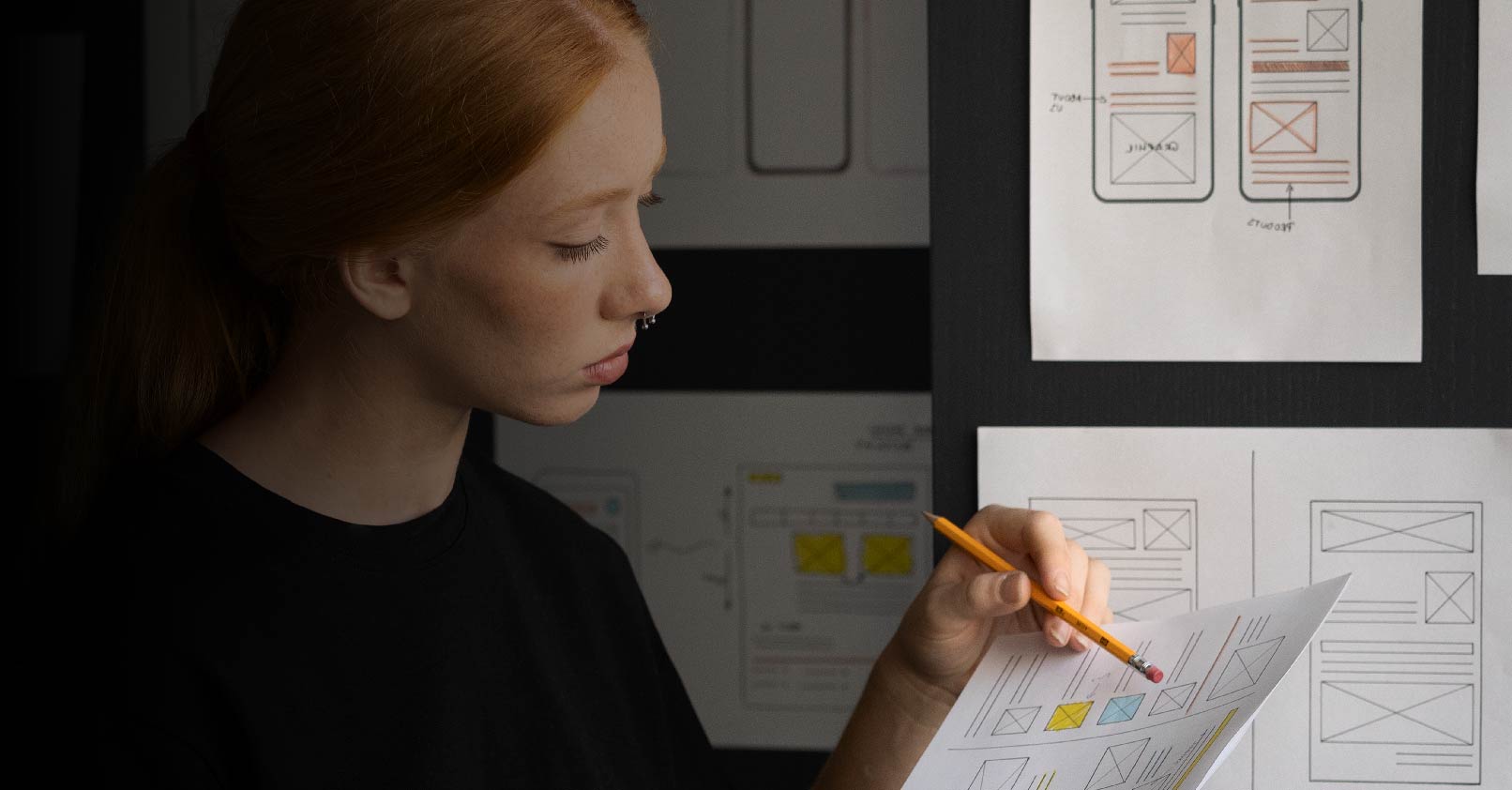Understanding the Impact of UI/UX Design on Business Succes
In today’s digital environment, businesses work hard to provide customers with a seamless and engaging user experience. UI (User Interface) design and UX (User Experience) design are pivotal in achieving this goal. UI/UX design services have become critical for businesses seeking to enhance customer satisfaction, boost brand loyalty, and gain a competitive edge. In this article, we will look at the significance/importance of UI/UX design services and how they can benefit businesses, particularly small enterprises.
Interesting Facts on UI/UX Design:
- After a negative user experience, 88% of online shoppers are less likely to revisit the same website. (Source: Econsultancy)
- Well-designed user interfaces can increase conversions by up to 200%. (Source: Forrester Research)
- Companies prioritizing UX design outperformed the S&P 500 index by 228% over a 10-year period. (Source: Design Management Institute)
What is UX Design?
User Experience (UX) design is the process of elevating customer satisfaction by enhancing a product or service’s usability, accessibility, and general user-product interaction. It focuses on understanding user needs, goals, and behaviors to create intuitive and enjoyable experiences.
Elements of UX Design:
UX design encompasses several key elements that contribute to creating a seamless and delightful user experience. Let’s delve deeper into these elements and understand their significance in the UX design process.
- User Research: User research is the cornerstone of UX design. It involves gathering valuable insights about user behaviors, needs, preferences, and pain points. Designers gain a deeper understanding of the target audience through surveys, interviews, and user testing. This information helps create user-centered designs that address specific user needs and expectations.
- Information Architecture: Information architecture focuses on organizing content and navigation to ensure logical and intuitive user flows. It involves structuring information, categorizing content, and creating hierarchical relationships between elements. A well-designed information architecture facilitates efficient navigation, making it easier for users to find what they are looking for, reducing frustration, and enhancing the overall user experience.
- Wireframing and Prototyping: Wireframing and prototyping are essential steps in the UX design process. Wireframes are simplified visual representations of the user interface, showcasing a digital product or website’s layout, structure, and basic functionalities. They act as a template for the design and allow designers to test and refine the concept before continuing. Conversely, prototypes are interactive design versions that simulate user interactions and provide a more realistic experience. By creating wireframes and prototypes, designers can gather feedback early in the process and make necessary adjustments to enhance usability and user satisfaction.
- Interaction Design: Interaction design defines how users interact with the product or interface. It aims to create user-friendly and intuitive interactions that smoothly guide users through their tasks. Interaction designers consider factors like visual feedback, micro-interactions, user flow, and gestures to ensure a seamless and enjoyable experience. By carefully designing the interactions, designers can enhance usability, engage users, and create positive emotional responses.
- Usability Testing: Usability testing involves evaluating the design with real users to identify areas for improvement. It offers insightful information on how users engage with the interface, where they have trouble, and which elements of the design work well. Usability testing helps designers validate their design decisions, identify pain points, and make data-driven improvements. By incorporating user feedback, designers can refine the user experience and create more intuitive and user-friendly designs.
In conclusion, UX design elements work together to create exceptional user experiences. User research provides insights into user behaviors and needs; information architecture ensures intuitive navigation; wireframing and prototyping enable testing and iteration; interaction design enhances user interactions; and usability testing validates the design and identifies areas for improvement. By incorporating these elements into the UX design process, businesses can create products and services tailored to user needs, resulting in higher user satisfaction, engagement, and, ultimately, business success.
What is UI Design?
The visual elements of a product or service, including the look, feel, and overall aesthetics, are the primary emphasis of user interface (UI) design. It involves crafting visually appealing interfaces that facilitate smooth and engaging interactions.
Elements of UI Design:
Let’s explore the key UI design elements and understand their importance in crafting effective and visually appealing interfaces.
- Layout and Composition: Layout and composition involve organizing elements on the screen to create a balanced and visually pleasing design. A well-structured layout ensures that information is presented in a logical and organized manner. It involves considering factors such as spacing, alignment, and placement of elements to create a visually unified interface that seamlessly guides users through the content.
- Typography: Typography plays a crucial role in UI design as it involves choosing appropriate fonts, sizes, and styles to enhance readability and establish a consistent brand identity. The right typography enhances the overall visual appeal of the interface, makes the content more legible, and creates a cohesive and recognizable brand image.
- Color and Contrast: Color and contrast are potent tools in UI design that can evoke emotions, guide user attention, and create a visual hierarchy. Designers can use color psychology to influence user perceptions and create a specific atmosphere or mood. Contrast is essential to distinguish between different elements and establish a visual hierarchy. It helps users navigate the interface and focus on important information.
- Visual Hierarchy: Visual hierarchy involves structuring content to prioritize important information and guide users through the interface. Using visual cues such as size, color, contrast, and placement, designers can direct user attention and help them understand the relative importance and relationships between different elements. A compelling visual hierarchy ensures that users can quickly and easily find the information they need, enhancing usability and user experience.
- Responsive Design: With the increasing use of various devices and screen sizes, responsive design has become a crucial element of UI design. Responsive design ensures that the interface adapts seamlessly to different devices, resolutions, and orientations. It involves creating flexible layouts, fluid grids, and scalable elements that maintain usability and visual appeal across multiple devices. Responsive design is essential for providing a consistent and optimized user experience, regardless of the device being used.
In conclusion, UI design elements work together to create visually appealing and user-friendly interfaces. Layout and composition establish a well-organized structure; typography enhances readability and brand identity; color and contrast evoke emotions and guide attention; visual hierarchy shows information prioritization; and responsive design ensures a consistent experience across devices. By incorporating these elements, UI designers can create interfaces that captivate users, facilitate easy navigation, and contribute to a positive overall user experience.
What is More Important, UI or UX?
Why is UX design important? Why is UI design important? What is more important – User experience design or User interface design?
While UI and UX design are closely related, they serve different purposes. UX design optimizes the overall user experience, while UI design emphasizes the visual and interactive aspects. Both elements are crucial and work hand in hand to create exceptional user experiences. Neglecting either aspect can result in a subpar user experience that may drive customers away. At the same time, a good ui ux design can help you gain more customers and retain the existing ones.
Why Do You Need UI/UX for Your Business Website or Application?
Good UI/UX design is crucial for businesses in today’s digital landscape. Let’s explore some of the benefits of UI/UX design and why investing in UI UX design services for your business website or application is essential for success.
- Enhanced User Satisfaction: Good UI/UX design creates positive impressions, builds trust, and fosters customer satisfaction.
- Increased Conversions: Intuitive and user-friendly interfaces can increase conversion rates, improving the bottom line.
- Competitive Advantage: In today’s crowded market, businesses must differentiate themselves. Exceptional UI/UX design sets you apart from the competition.
- Customer Retention: A seamless user experience encourages customers to stay longer, engage more, and become loyal brand advocates.
- Cost Savings: Investing in UI/UX design from the beginning helps avoid costly redesigns and development errors.
UI UX design services is essential for businesses to thrive digitally. The importance of user experience in the digital world is self-evident – It enhances user satisfaction, increases conversions, provides a competitive advantage, fosters customer retention, and helps in cost savings. By prioritizing UI/UX design services, businesses can create exceptional experiences that delight their users, drive business growth, and establish a strong brand presence.
What Advantages Does UI/UX Design Offer to Small Businesses?
Small businesses can significantly benefit from investing in UI UX design services. Let’s explore some of the trends of ui ux design and the advantages it offers to small businesses.
- Leveling the Playing Field: Small businesses can compete with larger players by offering outstanding user experiences.
- Building Trust and Credibility: Professional and user-centric designs instill confidence in potential customers.
- Better Customer Understanding: UI/UX design helps small businesses gain insights into their target audience and tailor their offerings accordingly.
- Increased Customer Engagement: Engaging interfaces increase customer interaction and encourage them to explore products and services.
- Long-Term Growth: Investing in UI/UX design establishes a strong foundation for growth, scalability, and customer retention.
UI/UX design offers significant benefits to small businesses. It helps level the playing field, build trust and credibility, gain better customer understanding, increase customer engagement, and establish a foundation for long-term growth. By investing in UI/UX design firms, small businesses can create a competitive edge, enhance customer experiences, and position themselves for success in the market.
Final Thoughts:
UI/UX design services are not mere luxuries but essential components for businesses aiming to succeed in the digital world. By prioritizing user experience, companies can create meaningful connections with their customers, increase conversions, and foster brand loyalty. Small businesses, in particular, can leverage UI/UX design to level the playing field, build credibility, and drive long-term growth. Investing in UI/UX design is a wise strategy that pays off in terms of customer satisfaction, competitive advantage, and business success.
Worxwide Consulting is a digital growth consulting firms that helps companies drive digital growth by improving user and customer experience. We help companies with end-to-end product design or UX design services that include research, strategy, design, and test product designs and prototypes. Worxwide is based out of the US, UK, and India offering bid consulting, sales transformation, user experience, and customer experience design services.

tx, USA

London, UK

India


